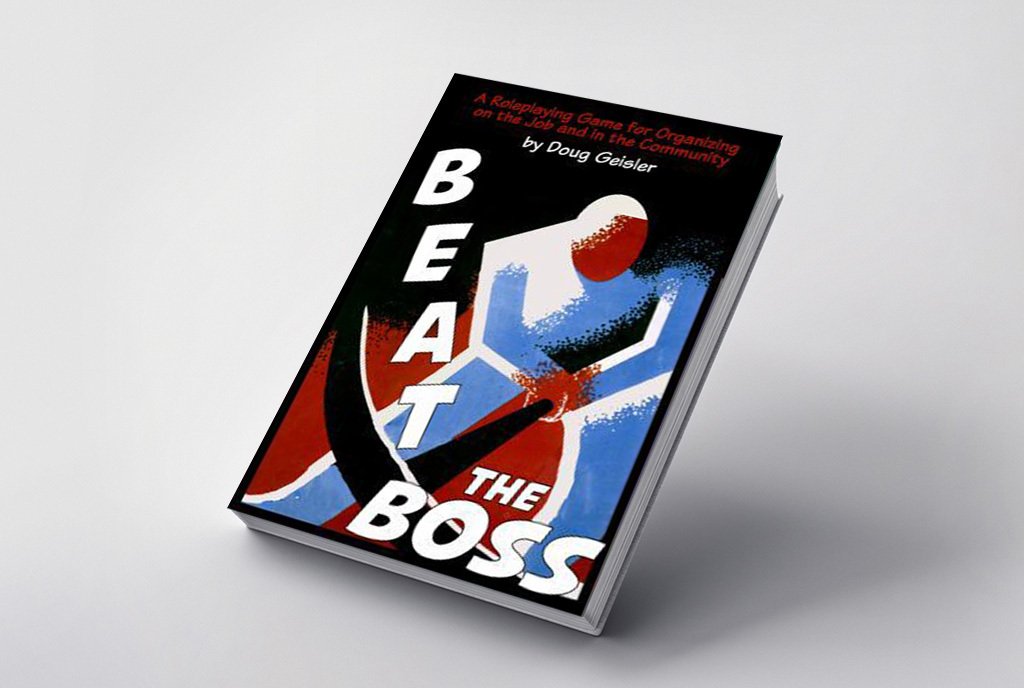
Picture this: you have just finished another grueling shift and decide to meet up with your friend to unwind. When you get there, you notice a drone—owned by your employer—hovering above. Your employer, among the richest corporations in the world, is slowly taking over every aspect of your city. It is converting all public infrastructure, including schools and sidewalks, to meet company needs.
Increasingly, groups…are seeking to use games as educational tools to promote social justice and upend the status quo.
No, it’s not Amazon, Apple, Google, or Walmart—it’s HappyCorp.
HappyCorp exists in the universe of STRIKE! The Game of Worker Rebellion. The board game is the brainchild of TESA (Toolbox for Education and Social Action) Collective, a worker co-op that designs games, workshops, and educational tools for social causes. The co-op believes that better games help people better “envision the world we want to live in.”
Games have often been used to reinforce existing social relations. (Monopoly is a perfect example of this.) But increasingly, groups like TESA are seeking to use games as educational tools to promote social justice and upend the status quo.
Connecting Gaming and Labor Unions
Brian Van Slyke, a TESA cofounder, says HappyCorp reflects, albeit perhaps in exaggerated fashion, many of today’s megacorporations. He views these companies as obsessed with gaining control of public resources—better known as privatization—which shows up in how HappyCorp controls the fictional Mercury City.
“A HappyCorp watch I was wearing would ding and say, ‘Okay, you’ve taken two steps on the sidewalk—that’s 10 dollars’,” Van Slyke said.
TESA Collective’s ties to the labor movement go back years. The collective began in Amherst, MA, at Hampshire College, a campus known for its progressive values. The founders connected over their involvement in justice movements, as well as a shared love of games.
“Most of us who started this organization are, frankly, nerds,” Van Slyke said.
They wanted their work to draw people toward social causes and found that incorporating gamification engaged people the most. Games were able to “reach people in a way that PowerPoints and presentations couldn’t,” according to Van Slyke.
Early on, TESA Collective began testing board games in pro-labor environments.
“We brought our first game to a little protest that was happening at the time called Occupy Wall Street,” Van Slyke said.
That led them to brainstorm a game centered around movement building. A few years later, they got an opportunity to bring that concept to life.
“We were actually approached by this awesome, fantastic organization called Jobs with Justice, one of the leading labor rights organizations in the country,” Van Slyke said.
Jobs with Justice was looking for something that would promote the labor movement, but that was not didactic.
“They wanted something that people who enjoyed playing strategy games would sit around [and] play during board game nights,” Van Slyke said.
And STRIKE! was born. In the game, players act as members of the STRIKE! Council, a group fighting against HappyCorp’s takeover of Mercury City. Players can take on one of eight roles that represent different types of employees—like Valentina, the factory worker; Eddie, the pilot; or Skyler, the nurse. Each character has specific advantages. For example, Skyler can quickly organize strikers.
The educational aspect of Beat the Boss comes through setting players up with a “menu of options” to move them through the different phases of organizing.
Players don’t play against each other; they work collectively to beat the game itself.
With each turn, players get to place four action cubes on the board. You can use those actions to do tasks like disassemble drones or move workers around Mercury City. Once players collect 15 points or get five drones off the board, they win.
Beat the Boss
STRIKE! is hardly the only game to promote labor organizing. Longtime labor organizer Doug Geisler had a similar idea in mind when he first envisioned Beat the Boss, a union-organizing role-playing game.
“It is an opportunity to simulate being an organizer in an organizing campaign and help workers win what they want at the job,” Geisler said. “It’s an opportunity to learn some practical skills about what organizers go through.”
In Beat the Boss, players run organizing drives, strike, ratify contracts, and take other actions that are very familiar to real-life shop stewards.
The educational aspect of Beat the Boss comes through setting players up with a “menu of options” to move them through the different phases of organizing.
Sign up for our free newsletters
Subscribe to NPQ's newsletters to have our top stories delivered directly to your inbox.
By signing up, you agree to our privacy policy and terms of use, and to receive messages from NPQ and our partners.
“What do they want to accomplish in [each phase],” Geisler said. “And what tactics are they going to use through it?”
Geisler, who’s based in Oregon, has been a labor organizer since the early 2000s. He’s currently a member growth strategist for SEIU (Service Employees International Union) Local 503, where he works with over 70,000 workers who are mostly in the public sector. Like the TESA crew, he has a lifelong relationship with gaming.
“I started role-playing like D&D [Dungeons & Dragons] when I was in late middle school,” Geisler said.
Beat the Boss gives organizers a chance to sharpen their skills. Geisler has noticed that some players who are in the movement in real life will “play against their own personality.”
“There’ll be someone who’s like a dyed-in-the-wool labor organizer, and they’ve been doing it for a number of years, and they want to try out the political organizer,” Geisler said.
Countering Anti-Labor Narratives
The tone of messaging from management plays a big role in both STRIKE! and Beat the Boss.
“What are the things that an evil corporation is going to say while pretending to be your friend,” Van Slyke said. “They’re never like actually, ‘Hey, we’re an evil corporation’. They’re like, ‘We’re one big family! No unions are needed’.”
In STRIKE!, players are forced to draw a commercial break card at the end of their turn.
“It says things like, ‘Hey, you can trust us! We’ll take care of the environment’,” Van Slyke said.
The games are different experiences for those who have organized before and those who haven’t. Players without union backgrounds sometimes feel the boss character’s expressions in Beat the Boss are unbelievable, according to Geisler. But the examples draw on real-life events.
“Those are things that have been said in campaigns that I’ve worked on,” Geisler said. “Those are actions that bosses have done.”
STRIKE! allows people to engage with organizing concepts and begin to feel a little more personal agency.
Fostering a Sense of Agency
STRIKE! also takes inspiration from labor organizers’ shared experiences, including the more mundane challenges, like organizing childcare before going to a protest. For some players, these games might be their first introduction to unionization. It gives nonunion workers a chance to learn while doing.
“I’m not saying they’re going to play this game and then they’re going to know how to organize a citywide strike,” Van Slyke said.
But Van Slyke does think STRIKE! allows people to engage with organizing concepts and begin to feel a little more personal agency. A decent amount of customer service requests to TESA come from email addresses with union names in them. Customers will share that they’re playing the game with union buddies or coworkers with whom they’re trying to start a local chapter.
“We’re actually already on our second printing of the game,” Van Slyke said. “People are buying it and talking about it.”
STRIKE! and Beat the Boss are just two examples of labor-focused games in a bustling social justice games environment. The last few years have seen a “total explosion of interest in making games about causes,” Van Slyke said.
At the same time, organizing momentum has shot up since the beginning of the COVID-19 pandemic.
“When you look at [organizing] 15 years ago, it was like this is a dying thing, and now it’s like, oh, this is on the rise again,” Van Slyke said. “It sort of feels like a phoenix from the ashes.”
Of course, these recent pushes haven’t come out of nowhere.
“There are people who’ve been working on that for years and years and years,” Van Slyke said. “And it’s amazing to see the fruits of their labor.”
As more pro-labor games enter the market, these games may help continue to spark interest in labor organizing among a wide group of workers. In the case of STRIKE!, Van Slyke thinks the game can give its players the ability to better imagine their futures and take back their power from corporations.
“There’s a little bit of hope when you see yourself as an active player,” Van Slyke said.














